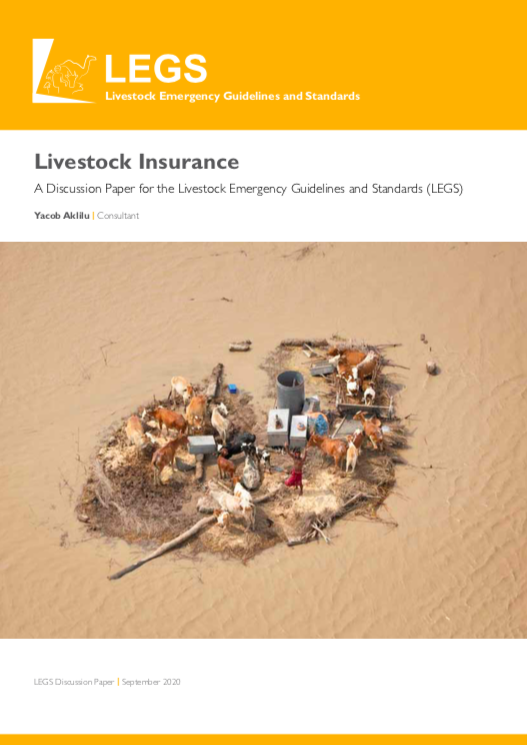Livestock Insurance: A Discussion Paper for the Livestock Emergency Guidelines and Standards (LEGS)

EXECUTIVE SUMMARY
This Discussion Paper analyses the impact of livestock insurance schemes on the livelihoods of communities affected by crises and makes recommendations on the relevance of livestock insurance to LEGS and for the next edition of the LEGS Handbook. The paper discusses two livestock insurance systems: traditional systems (including both conventional systems and traditional social insurance schemes) and emerging livestock insurance schemes such as loan-based schemes and Index-Based Livestock Insurance (IBLI).
The systems of social insurance schemes traditionally used by herders, particularly in East Africa, are becoming less effective and increasingly overwhelmed by the ever-growing needs of destitute livestock keepers. Traditional insurance companies provide coverage solely for commercial livestock farms, viewing smallholders as uninsurable. In some countries, governments and NGOs facilitate loans tied to insurance schemes for small livestock farmers. In both cases, payouts are made on case-by-case assessments of individual clients’ loss. Conversely, IBLI makes payouts based on external indicators and principally targets formerly uninsurable pastoral/agro-pastoral groups.
BLI in Mongolia uses dzud (extreme cold weather) as an external indicator expressed by herd mortality levels. In this specific case, herders cover the costs of up to 10% of livestock mortalities, while insurance companies make payouts when herd mortality levels exceed 10% but up to a maximum of 30% (i.e. for 20% of mortality losses). Losses of above 30% are covered by the Government. Payouts are intended for livestock replacements.
IBLI targets households that have a critical number of livestock to avoid them falling into destitution e.g. in Mongolia 200 animals. In Mongolia, banks offer interest discounts on loans if herders purchase insurance; and in Kenya and Ethiopia incentives include premium subsidies ranging from 10 to 100%. Government/NGO sponsored loan-tied insurance schemes also apply premium subsidies and/or discounts on loan interest rates.
The major challenge for IBLI is sustaining the profitability of insurance companies while making the system attractive enough for herders to buy annual premiums. This concern in Mongolia, for example, restricted the liability of insurance companies for indemnities to 20% of mortality losses, and herders received only two payouts (totaling $615,700) between 2006 and 2015, while insurance companies amassed profits of US$100 million – which implies that herders have been financing insurance companies with $10 million per year. Such details are not available for IBLI Kenya and Ethiopia but herders receive payouts only if forage scarcity exceeds 80%. The payment they receive depends on the specific index readings in the payout months consisting of a proportion rather than the full indemnity amount. At the lowest, herders may only receive 5% of the full indemnity level for which they are insured. Insurance companies have also become adept at increasing premium rates without a matching increase in indemnity levels e.g., in 2017/18, the premium rates in Borana, Ethiopia varied between 7.27% and 11.11%, while for a new IBLI project in Eastern Ethiopia (with lower drought frequency than Borana), the premium rate in 2020 was raised to 16.15%.
IBLI is an experimental intervention that currently falls outside the realm of LEGS. Only two projects have been running for over 10 years with fluctuating numbers of policy holders from one year to another. Some IBLI projects are designed to last for five years or less and the continuity of such projects is questionable when the subsidy stops. As a result, the sustainability and increased adoption of insurance schemes can only be asserted when a representative proportion of livestock keepers become policy holders, which will take some years to prove. Insurance companies are disproportionately benefitting (although they have to remain profitable) from premiums they collect compared to the proportion of indemnities they payout to policy holders. To summarize, current evidence suggests that it is too early to advocate for including IBLI, or loan + insurance schemes, into the LEGS Handbook at present.